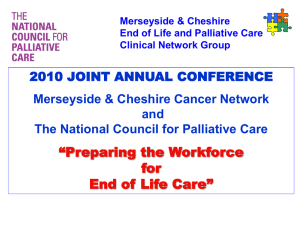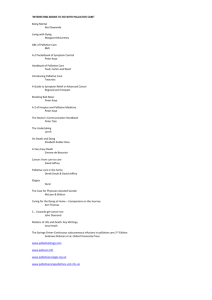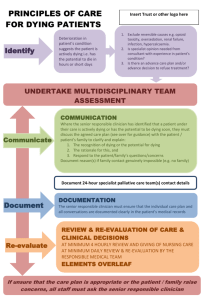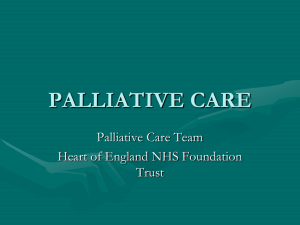What People Want to Live and Die Well
advertisement
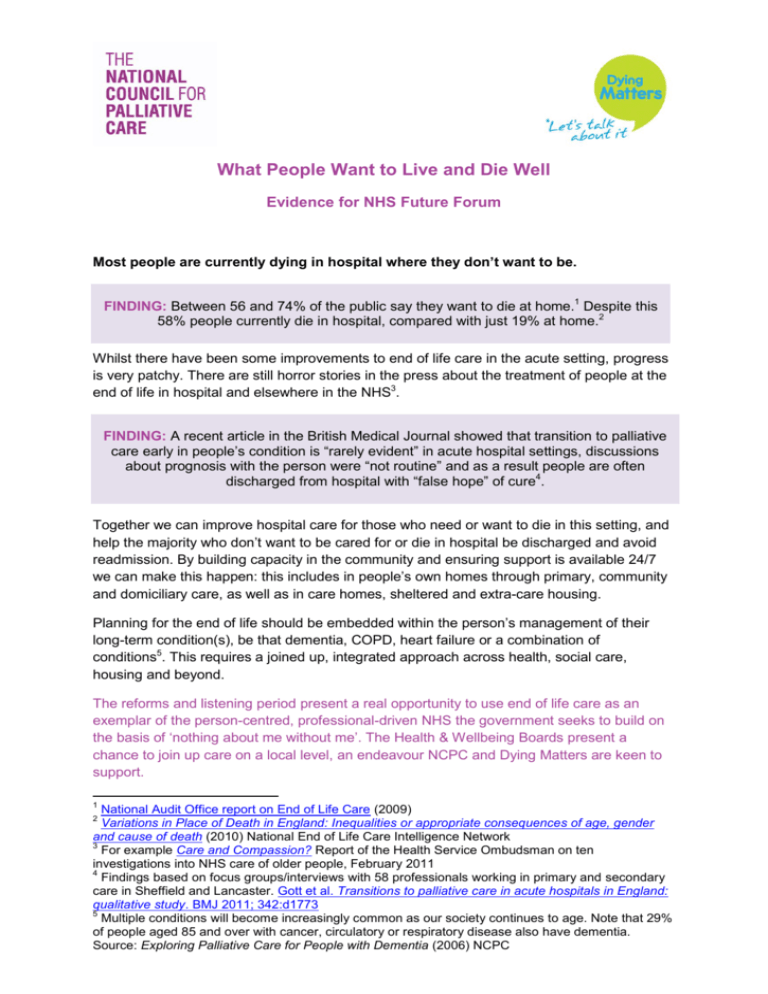
What People Want to Live and Die Well Evidence for NHS Future Forum Most people are currently dying in hospital where they don’t want to be. FINDING: Between 56 and 74% of the public say they want to die at home.1 Despite this 58% people currently die in hospital, compared with just 19% at home.2 Whilst there have been some improvements to end of life care in the acute setting, progress is very patchy. There are still horror stories in the press about the treatment of people at the end of life in hospital and elsewhere in the NHS3. FINDING: A recent article in the British Medical Journal showed that transition to palliative care early in people‟s condition is “rarely evident” in acute hospital settings, discussions about prognosis with the person were “not routine” and as a result people are often discharged from hospital with “false hope” of cure4. Together we can improve hospital care for those who need or want to die in this setting, and help the majority who don‟t want to be cared for or die in hospital be discharged and avoid readmission. By building capacity in the community and ensuring support is available 24/7 we can make this happen: this includes in people‟s own homes through primary, community and domiciliary care, as well as in care homes, sheltered and extra-care housing. Planning for the end of life should be embedded within the person‟s management of their long-term condition(s), be that dementia, COPD, heart failure or a combination of conditions5. This requires a joined up, integrated approach across health, social care, housing and beyond. The reforms and listening period present a real opportunity to use end of life care as an exemplar of the person-centred, professional-driven NHS the government seeks to build on the basis of „nothing about me without me‟. The Health & Wellbeing Boards present a chance to join up care on a local level, an endeavour NCPC and Dying Matters are keen to support. 1 National Audit Office report on End of Life Care (2009) Variations in Place of Death in England: Inequalities or appropriate consequences of age, gender and cause of death (2010) National End of Life Care Intelligence Network 3 For example Care and Compassion? Report of the Health Service Ombudsman on ten investigations into NHS care of older people, February 2011 4 Findings based on focus groups/interviews with 58 professionals working in primary and secondary care in Sheffield and Lancaster. Gott et al. Transitions to palliative care in acute hospitals in England: qualitative study. BMJ 2011; 342:d1773 5 Multiple conditions will become increasingly common as our society continues to age. Note that 29% of people aged 85 and over with cancer, circulatory or respiratory disease also have dementia. Source: Exploring Palliative Care for People with Dementia (2006) NCPC 2 The fact that people don‟t talk about their wishes for the end of life makes it harder for people in the NHS, social care and beyond to address this. FINDING: A NATCEN survey for Dying Matters found that whilst 68% of the public said they were comfortable talking about it death, less than a third had discussed their wishes around dying and only 4% had written an advance care plan6. The Dying Matters coalition, funded by the Department of Health and led by NCPC, has been working hard to tackle the taboo which exists around dying, death and bereavement on both the national and local level. We have a wealth of evidence and good practice examples available to the Future Forum should you wish to build on this work. The economic and pragmatic case Getting end of life care right saves money. The National Audit Office‟s 2008 investigation into end of life care provided a wealth of evidence on cost savings that can be made by giving people more choice at the end of life, delivering care in the community and avoiding hospital admissions7. The Quality, Innovation, Productivity and Prevention (QIPP) End of Life Care workstream is building on this work.8 The palliative care approach is both valued and valuable. FINDING: A study in the BMJ found that early access to palliative care at the point of diagnosis can lead to significant improvements in both quality and length of life9. There is a wealth of qualitative research on the benefits of palliative and end of life care as directly reported by people and their carers. NCPC has been leading the way in this area – see Appendix 1 below for an overview of our work and how it has been used at the local level. A key message is that carers must be supported to care. This applies particularly at the end of life where people are desperate to do the right thing for their loved one, but are often left unsupported or are lost in the system. Joining up the national end of life care strategy (2008) 6 NatCen survey on attitudes towards dying, death and bereavement commissioned on behalf of Dying Matters, July-September 2009 7 See for example Identifying Alternatives to Hospital for People at the End of Life and The potential cost savings of greater use of home- and hospice based end of life care in England 8 A collection being developed by NHS Evidence to support quality and productivity at a local level, including around long-term conditions and on end of life care: www.evidence.nhs.uk/QIPP 9 The study found that „early integration of palliative care with standard oncologic care in patients with metastatic non-small-cell lung cancer resulted in survival that was prolonged by approximately 2 months and clinically meaningful improvements in quality of life and mood‟ Early palliative care for patients with metastatic non-small-cell lung cancer, Temel JS et al. New England Journal of Medicine 2010;363(8):733-42 2 with the carers‟ strategy (2008, refreshed in 2010) both on the national and local level is an important part of this. From an economic point of view, it is estimated carers save the UK £87 billion a year.10 We cannot afford to waste this support. At the same time we cannot assume that everyone will have a carer available to them. FINDING: The number of people aged between 45-64 living alone has jumped by a third in the past decade, from 1.78 million in 2001 to 2.33m in 201011. This trend has profound implications for palliative and end of life care, with decision-makers across the board - health, social care, housing, private and voluntary sector - required to rethink how they plan, commission and provide appropriate services for people in their communities who are ageing but may not have support available from spouse, sibling or other unpaid carer. Making this happen Leadership and campaigning The government‟s reforms of commissioning to increase the involvement of local clinicians and Local Authorities, as well as increase emphasis on public health, bring new opportunities to influence commissioning culture and decision-making, at local and national level. This will require leadership, campaigning and champions at every level both locally and nationally. NCPC and Dying Matters will be equipping local leadership and campaigners to ensure end of life is a priority in their organisations and localities by publishing a series of short, tightlyfocussed practical check-lists to help commissioners and providers develop end of life care in the reformed landscape. Build community capacity We cannot simply rely on hospices to deliver this care. With about 500,000 people dying in England and Wales each year (which is predicted to rise to about 590,000 by about 203035) they don‟t have capacity and are not sufficiently accessed by people with conditions outside cancer. The specialist palliative care expertise of hospices has an important role in developing capacity in the community setting – for example, by skilling up people who work in care 10 Valuing Carers – calculating the value of unpaid care Carers UK and University of Leeds Families and households in the UK, 2001 to 2010 Office of National Statistics (2011) and widely reported by media, including the BBC Today programme (15 April 2011) 11 3 homes, sheltered and extra care housing to talk about and meet their residents‟ wishes for the end of life. Access to 24/7 care and support There is an urgent need for more capacity, support and out of hours care in the community to help people be cared for and die in their preferred place and to avoid unnecessary admissions to hospital. This was a clear message from NCPC‟s Dying Out of Hours conference, held jointly with Macmillan Cancer Support. Survey findings carried out in relation to this can be found in Appendix 2 below. Giving people what they want requires that people tell us A public health approach to address public taboo of dying, death and bereavement which stops people planning for the end of life is urgently needed. This must be recongised at every level – from embedding an outcome measure in the public health framework (currently lacking), recognition by local Health & Wellbeing Boards and built into JSNAs and their strategies, to public information strategies for public awareness which Dying Matters can help with. Measuring outcomes The government have placed a particular emphasis on outcomes, an approach we welcome for palliative and end of life care. The suggested outcome measure for end of life care in the NHS Outcomes Framework for 2011/12 is a survey of bereaved carers. Studies are underway at the University of Southampton (IMPROVE Survey) and Cicely Saunders Institute at King‟s College (QUALYCARE) to explore how such questionnaires can be used most effectively to capture people‟s experiences in the last months of life and to improve services. The Department of Health have commissioned the IMPROVE Survey with a view of it becoming the national outcome measure for end of life care. NCPC is supporting the development of this measure, and believes that it will need to be used alongside other measures to ensure people get the care they need at the end and commissioners are held to account when they do not. Professionals who support people with long term conditions and older people should all be confident talking about dying, death and bereavement and able to help people plan for the end of life. Helping generalists to do this was a key aim of the End of Life Care Strategy and is absolutely essential in helping all people get the death they want and deserve. The DH has 4 already invested in e-learning tools for end of life care, which will make an important difference. However other types of education and training are also needed. For example, Dying Matters has piloted a project to improve GP confidence levels in having discussions with people about their end of life. The evaluation shows increased confidence levels and changes in practice by GPs. Read more here. Tools such as the Map of Medicine can help ensure services across settings are operating in a consistent and coordinated way. Localities have adapted the national Map of Medicine locally, activity which is attracting international attention12. Findings of End of Life Locality Register Pilots will be important to deciding how best to identify people approaching the end of life and the better coordination of their care across settings13. What NCPC and the Dying Matters coalition can provide We can provide additional evidence on the areas set out above, in particular: Models of good practice Qualitative evidence on what support and services people and carers want (see Appendix 1) Cost savings Specialist palliative care workforce data Data from specialist services about their levels of activity and the people they care for We can also provide guidance and resources tailored to different settings and conditions. For example, care homes, neurological conditions, communication guidance, advance care planning and decision-making guidance. Our regular policy bulletins provides a monthly overview of the latest research and developments in hospice, palliative and end of life care, with analysis from NCPC. We have offered intelligence, including our Minimum Data Sets on Specialist Palliative Care, to national reviews such as the Palliative Care Funding Review currently underway led by Tom Hughes-Hallett. It is hoped that the review will help to establish a fair and transparent funding model which better supports the palliative care services currently being provided by the voluntary sector. It will also inform the „national choice offer‟ the government wishes to introduce to ensure people can achieve a good death. We are happy to provide further evidence and support to the Future Forum as required. 12 Devon and Cornwall have been working with the Map of Medicine for some years. Most recently NHS Devon health and social care community have localised the end of life care pathways on the Map of Medicine onto GP computer systems. Contact l.potter@ncpc.org.uk for more information 13 An interim report can be found here. The evaluation team anticipate that cost savings will be demonstrated by sites, particular around reduction in unscheduled care and thus hospital admissions/deaths, with caveat that is too early to know for certain at this time. 5 About NCPC The National Council for Palliative Care (NCPC) is the umbrella charity for all those involved in palliative, end of life and hospice care in England, Wales and Northern Ireland. We believe that everyone approaching the end of life has the right to the highest quality care and support, wherever they live, and whatever their condition. We work with government, health and social care staff and people with personal experience to improve end of life care for all. NCPC is a registered charity number 1005671 and a company limited by guarantee number 2644430. www.ncpc.org.uk About Dying Matters Dying Matters is a national coalition led by NCPC which aims to support changing knowledge, attitudes and behaviours towards dying, death and bereavement, and through this to make „living and dying well‟ the norm. The Dying Matters Coalition, which currently has over 14,000 members, is working to address this by encouraging people to talk about their wishes towards the end of their lives, including how they would like to be cared for, where they want to die and their funeral plans, with friends, family and loved ones. To find out more about the range of resources available or to join visit www.dyingmatters.org 6 Appendix 1 Listening to What People Want: NCPC‟s Public Involvement Work NCPC is the leading source of work in the field of user involvement in end of life care. We have an extensive people bank and database of case studies and stories of those with personal experience of end of life care, whether their own or their loved ones. Our approach is to work jointly with communities to develop messages and information appropriate to society. We have produced a number of resources jointly with people with personal experience to inform commissioners and providers of end of life care about what people want as well as help for organisations to engage with their own communities including: A Guide to Involving Patients, Carers and the Public in Palliative Care and End of Life Care Services produced with the National Centre for Involvement. This resource has been downloaded over 35,000 times since its launch in 2009. View it here. Small is Beautiful: Identifying the small things which make a big difference to end of life care. This approach has been adopted by a range of organisations at the local level. Difficult Conversations: Communicating with people with Chronic Obstructive Pulmonary Disease about the End of Life is based entirely on the views and experiences of people affected by COPD (Patients, carers and former carers). This is widely used by health and social care professionals to support and initiate conversations about end of life wishes 24/7 care: We asked our People Bank how 24/7 care should be delivered at the end of life. This has been used to inform commissioners about what is needed What does spiritual support mean to you? We asked our People Bank what spiritual support means to them, in the context of end of life care. Comments are now being used to train chaplains and those that provide spiritual support in how best to deliver it. Getting started is an introductory guide to involving people with personal experience in end of life care Can you see me: A film to inspire and empower providers and commissioners of end of life care „to think to the far corners of their communities‟ and provide care to people who are often overlooked including those who are homeless, from minority ethnic communities and with conditions other than cancer. Now widely used for training health and social care professionals. Copies of these resources can be made available to the Future Forum as needed. 7 Appendix 2 Findings from 24/7 Care Survey (March 2011) Dying out of hours: summary results from NCPC’s survey on out of hours care Findings in brief: Access to home nursing and to pain relief were the most frequently identified priorities for local 24/7 end of life care development 59% of respondents reported there were gaps in 24/7 local access to specialist palliative care nursing 49% didn’t think that all people in their area had 24/7 access to specialist palliative care pain relief if needed Most service gaps occur overnight with the best out of hours cover available during weekend day time A quarter of respondents currently providing some out of hours services thought they were likely to be affected negatively by changing funding arrangements Access to 24/7 care was one of the central themes of the End of Life Care Strategy (2008) and is an 14 area of continuing national priority. Evidence suggests, however, that significant gaps in provision remain; Macmillan Cancer Support found that 24/7 community nursing for end of life care was only 15 available in 56% of PCTs. Most recently, The NHS Operating Framework for 2011/12 reiterated the need for adequate 24/7 community services for end of life care following the Palliative Care Funding Review‟s interim report (2010) which had highlighted lack of 24/7 access to care as „a major barrier to delivering the most 16,17 effective, efficient services‟. NCPC surveyed provider organisations at the start of 2011 to ascertain what types of services they offer out of hours (OOH) and what their concerns were for local 24/7 care. In this survey, OOH was defined as anytime other than 9am to 5pm, Monday to Friday. Respondents 14 Department of Health, End of Life Care Strategy, 2008 Macmillan Cancer Support, Always There? The impact of the End of Life Care Strategy on 24/7 community nursing in England, 2010 16 Department of Health, The Operating Framework for the NHS in England 2011/12, 2010 17 Palliative Care Funding Review, Interim Report, 2010 15 8 18 Over 90% of our respondents did provide some type of OOH service (175/188). Most frequently the respondents had some type of hospice (inpatient) service within their organisation but they also covered services in acute hospitals, primary care settings and care homes. Respondents were predominantly operating in England, but 9% of responses covered parts of Wales (8/93). Over three-quarters of services providing an OOH service had been doing so for over 3 years (70/90) and nearly half for over 10 years (42/90). What’s provided? The OOH service most frequently provided by respondents was telephone advice to health and social care professionals (71/92). The availability of this service was fairly evenly spread across the different time periods. It was closely followed by telephone advice to people with palliative or end of life care needs (or their carers) who were known to the service. 74% of respondents providing any OOH service offered this for at least some period OOH (68/92). Two thirds of respondents did take some inpatient admissions out of hours (62/92). These were most frequently during weekend days and/or bank holidays, approaching twice the number of those taking admissions overnight (58 cf 30). Chart 1: Types of services provided out of hours (multiple answers permitted) We asked respondents what types of care they provided during OOH home visits. They were most likely to be assessing symptoms, or providing emotional support to the carers/family or to the individual approaching the end of life. They were least likely to provide medication or to prescribe it. In fact, across all respondents, 42% said they did not have access to medication out of hours (38/91), although this does not necessarily mean that the people receiving their care were not able to access medication out of hours via other professionals or services. 18 The survey was completed by 86 respondents and we received a further 102 partially completed responses. 9 Chart 2: Types of care provided during home visits out of hours (multiple answers permitted) What’s missing? Access to home nursing and to pain relief out of hours were identified as the main priorities in local 24/7 end of life care provision. (61% of respondents selected the former and 57% the latter; respondents were allowed to select multiple choices.) In 2009/10, PCTs identified they had collectively invested an additional £6,104,356 into „rapid response/24hr community services‟, 8% of 19 the total new investment into end of life care reported to the Department of Health. Despite this, 59% of our respondents thought there were still gaps in local service provision of 24/7 specialist palliative care nursing for people who needed it 49% thought there were gaps in 24/7 local access to specialist palliative care pain relief „Overnight‟ was the least well covered for all types of services and was highlighted as an area of concern in many of the respondents‟ comments. Respondents referred to generic OOH services not knowing the person involved as well, nor sometimes having fast enough access to medication. The best cover across all the types of services identified was available during the weekend day. Results suggested OOH services were less well developed to support care home visits. Respondents were least likely to provide OOH visits to care homes (43/92) and only 18 respondents said they provided any overnight visits to care homes (see Chart 1). However, we do not know from this survey what proportion of telephone advice was given to care home staff during OOH. 19 Department of Health, End of Life Care Strategy: Second Annual Review, 2010 10 Funding A quarter of respondents feared that their current OOH service(s) would be negatively impacted by revised funding arrangements over the next 18 months (23/93). Respondents currently not providing OOH services raised funding and staffing as factors that might prevent them from developing these over the next year. Recommendations & conclusions There is a continuing need for comprehensive out of hours services to ensure 24/7 access to specialist palliative care advice, nursing and pain relief in every area for everyone who needs it. It will not be possible to support more people to die well in their own homes, if that is their choice, without better access to care OOH. We know from our work with people with personal experience that gaps in service OOH can cause long lasting distress and pain to the person approaching the end of life and to their carers. It is essential that services are developed which respond to people‟s wishes and preferences rather than being led by historical precedent. PCTs and emerging GP consortia must prioritise working with people with personal experience and providers to develop their local OOH services for end of life care. Commissioners must continue to invest in OOH end of life care services now and address the existing gaps. The current funding constraints must not be used as an excuse to reduce OOH services. It will be important to monitor PCTs‟ investment in 24/7 community services for 2010/11 within the Department of Health‟s second round of monitoring of the End of Life Care Strategy investment. Partnership working is fundamental to end of life care. Over half of respondents provided their OOH service in partnership with other services and such approaches should be encouraged to ensure as wide a level of provision as possible. It would neither be appropriate nor sustainable for all OOH care to be delivered by specialist services. Respondents highlighted the important role of primary care and social care services in supporting people OOH. The tendency towards telephone advice services for other health and social care professionals OOH reflects the importance of generalist OOH staff having access to more specialist advice as they need it. Earlier discussion and planning for end of life care will help to avoid crisis situations, particularly for people wishing to live and die in their own homes. The work of the Dying Matters coalition to support earlier conversations about people‟s choices is an important aspect of this. Tools to support anticipatory prescribing, such as just in case boxes, and communication with OOH teams, such as local registers, must also continue to be developed to improve continuity of care and support general OOH teams in their role. 11
